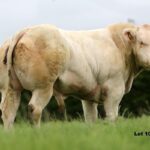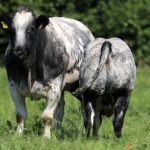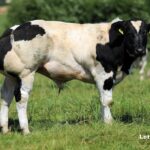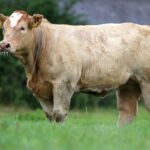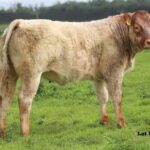That’s Farming, speaks to John Kingham, who is the manager of one of Ireland’s largest suckler farms, Tateetra and Rathmore Farms, ahead of its upcoming sale in this week’s Suckler Focus.
Over 150 heifers and 18 weanling bulls will come under the hammer at Tateetra & Rathmore Farms’ fourth annual sale at Carnaross Mart this Friday, September 23rd, 2022.
This year’s consignment includes a selection of show-quality, some of which are halter trained, Limousin-cross, Belgian Blue-cross, Charolais-cross, and roan entries.
Heifers are generally from 300kgs-550kgs, while bull weanlings, which are included in the sale for the first time since its inception, generally range from 350kgs-600kgs.
All animals are export tested (with the Department of Agriculture, Food and Marine on-site on sale day), vaccinated for pneumonia and dosed for internal and external parasites.
Tateetra and Rathmore Farms
Ahead of the sale, he told That’s Farming:
“In my opinion, there is serious demand for breeding stock, and it is good to see it. The sale attracts repeat customers, including some from Northern Ireland. I put emphasis on breeding good quality female heifers for the replacement market.”
“Stock stand for themselves with something on offer for everyone. We breed the best bulls to the best dams to produce the best calves. There is serious potential for showing and breeding among these calves,” he added.
Leading the way at last year’s sale, which achieved a total clearance and saw some Northern Ireland purchases) was a Charolais-cross-Simmental heifer at €5,500, with a sale average of €1,550.
John received “good” reports following last year’s sale; one entry, from which, secured the champion Simmental heifer silverware at the 2021 Carrick Winter Fair.
Among this year’s entries are ten Charolais-cross-Simmental and Charolais-cross-Limousin heifers from the same sire, Culla NSO (by BonJovi), as last year’s sale topper.
You can view all livestock on offer in Carnaross Mart from 3.30 pm on Friday, September 23rd, before the sale commences at 6 pm.
There will be online bidding through LSL Auctions’ app and ringside bidding.
Breeding programme
John runs a 500-cow herd of mixed breeds, including Belgian Blue, Simmental, Limousin, and roan-type females, and favours a 750kgs-900kgs cow with “super” maternal characteristics.
Alongside its AI programme, the enterprise runs 20 stock bulls, including Ardlea Nemo, (Limousin) Culla NSO (Charolais), Culla Oscar 2, (Charolais) Culla Oscar 3, (Charolais) Creaga Nord, (Shorthorn), Thornford Lenny (Simmental) and Broomfield King Fancy (Simmental).
AI sires used on the farm include Chocolat d’Ochamps (BB6634), Elderberry Galahad (EBY), Slieve Pablo (LM7266), Loyal (LM4184), BLACK N BLUE DIESEL ET (S1123), Goose Jericho (SG1283), Elite Forever Brill (TVR), and home-bred stock bulls.
Meanwhile, weanling bulls are sons of renowned AI bulls, including Elderberry Galahad (EBY), Chocolate, Loyal (LM4184) and his own team of stock bulls.
Since That’s Farming last interviewed John, he has invested in stock bulls, including a Blonde d’Aquitaine from Abbie Westcott in the UK, a Limousin from the Ballyrobin Livestock herd and a Charolais from the Tonyglasson herd.
John is “mixing up” his breeding programme to “better” his system through ET work and will hold a new heifer and bull sale in early 2023 – where animals will be halter-trained.
John’s brother Paul Kingham undertakes AI and scanning, which includes a pre-scan and a further scan on cows after 30 days.
Paul AI’d 70 cows in one day, 66 females of which held and will calve down progeny that will feature in the new sale.
He AIs heifers generally between 23-24 months-old, and AIs all cows first and introduces the bull to groups of 30 cows, two days afterwards for 21 days to mop up.
This year, the farm expects a larger number of AI-bred calves, arising from a 75% conception rate from conventional semen and a 55% conception rate for ET, which ABS and AB Ireland conduct.
Calving
He calves his heifers at 32-33 months, with over 150 cows and 100 replacement heifers expected to calf from October to the end of November, with calving season concluding in March.
John aims for one cow per calf per year and opts for this age for a “big powerful” female.
These calving dates suit his grass-based system, as he gets more output from grass and higher weight for age gains. Plus, calves are stronger to suckle their dams and adapt to the elements in March.
Kingham said the farm performed 26 C-sections last year, which included six ET calves. He regards this number as a “very low” figure regarding C-sections per heifer per 100.
He intervenes in many calvings, but as the farm manager said, “when you are going up in genetics, you are better than the breed, and you need to be there”.
“So, you cannot be sleeping on the job; therefore, you will not be in this game if you sleep on the job.”
“For example, the bulls we use are much harder calved, have better pelvic conformation, have better mothering ability, and bring a different animal aboard.”
The farm will change its calving system from October to March in 2023 and will push it back to February in five years.
“In my opinion, when you go into that late April calving, there is a younger calf, and the weather around April or May will be hard on calves to go out to grass.”
Future of Irish farming
In Budget 2023, he requests that the government gives all farming sectors “fairness”, “looks after” rural Ireland and offers farmers “a couple of euros extra per cow to keep the ball rolling”.
“If the government does not have Irish farmers or farming in Ireland, the country will be a very lonely spot.”
“Suckler farming in Ireland will stay strong, and the people in suits will not change it any different. The only thing they are going to do is try to crucify us, but without the farmers of Ireland, there is going to be no food or no future.”
“I want every farmer from 1-300 cows, whatever your business is because we are all in the one game. We try to have a variety of cows to suit all customers around the country and in the UK,” he told That’s Farming.
“You are not going to make millions out of farming, but if you get a turn here and there, it keeps the thing going around.”
“So, people reading this article on That’s Farming today need to start backing the farmer quicker than the politician,” Kingham concluded.
Photos of some lots catalogued: [Picture credits: Tricia Kennedy]
To share your story like this suckler farmer, email Catherina Cunnane, editor of That’s Farming, – [email protected]
See more suckler farming articles



